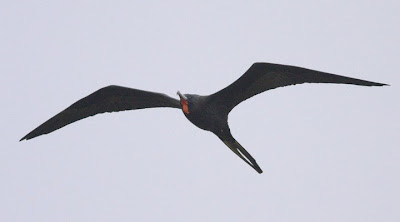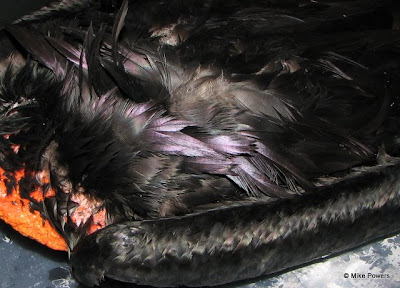I was fighting with electronics, bungee cords, and duct tape, trying to mount a skyward-pointing microphone; Tom and Shawn were hoping for a few shorebirds pausing in their southward migration. And as I was serenaded by a cacophony of Blue Jays, American Crows, and Canada Geese, they discovered a Magnificent Frigatebird.
 The first Magnificent Frigatebird observed in the Cayuga Lake Basin,
The first Magnificent Frigatebird observed in the Cayuga Lake Basin,discovered 21 September 2008 by Cornell students Shawn
Billerman and Tom Johnson. Photo © Tom Johnson
That's huge, so let me repeat that in a slightly different way: Shawn and Tom were watching a Magnificent Frigatebird, not while standing on a beach in Ft. Myers, Florida, but from the middle of the Finger Lakes region in central New York. Within hours (probably minutes) a regiment of birders (sadly, not including me) mobilized and had stellar observations from various points around the south end of the lake. Updates hit the Cayugabirds listserve fast and furious: still circling over Myer's Point, spotted from East Shore Marina, easily observed from Stewart Park.
 Magnificent Frigatebird and Ring-billed Gull - one is expected
Magnificent Frigatebird and Ring-billed Gull - one is expectedon Cayuga Lake, the other, not so much. Photo © Tom Johnson
Birders spent the afternoon tracking it as it swirled above Cayuga Lake, tracking it until dusk when it roosted with a gulp of Double-crested Cormorants on a dead tree just west of Stewart Park (did you know a group of cormorants is called a "gulp," according to this USGS page?). Evening posts announced the best locations to watch the bird when it left the roost tree the following morning while some observers, noting the bird's odd posture, such as the drooping primaries and how it held its head between its wrists, speculated about the health of the bird.
 Photo © Tom Johnson
Photo © Tom JohnsonSadly, two things were not to be: I wasn't able to make the pre-sunrise trip, which is all for the best as the bird was not in the roost tree when the sun rose. It had expired during the night and was spotted floating in the water. A local birder salvaged the bird, depositing it with the Cornell University Museum of Vertebrates where it will be prepared for addition to the specimen collections.
 Shawn Billerman photographs the Magnificent Frigatebird
Shawn Billerman photographs the Magnificent Frigatebirdhe co-discovered just days before. The bird will be
prepared for placement in the museum's collection.
During a season when we're all searching for boreal-breeding warblers, sparrows, and the other songbirds that are passing through our area, or focusing on concentrations of raptors streaming by hawk-watching sites, you've got to wonder, "How did a frigatebird make its way from (presumably) the Gulf of Mexico to central New York? And why didn't it survive the night?"
Magnificent Frigatebird observations reported to eBird.
Darker greens show higher frequency of observations,
depicting the expected range. Scattered light green in
the lower-48 are observations of vagrant individuals.
Darker greens show higher frequency of observations,
depicting the expected range. Scattered light green in
the lower-48 are observations of vagrant individuals.
The most obvious answers are hurricane winds and starvation. Hurricane Ike, which made landfall near Galveston, Texas on Friday, September 12, probably carried this bird, along with many other offshore species, onshore. As the storm dissipated the birds made their way towards any large, open body of water. This individual potentially crossed some eight or nine states as it hopscotched across the coastal plain of Texas, Louisiana, and Mississippi, the central hardwoods of Tennessee and Kentucky, and followed the Appalachians through West Virginia, Ohio, and Pennsylvania before arriving 1,300 miles away from where it started its overland journey on September 21.
After a journey like that a common assumption is that the bird is starving - what does a bird that spends the majority of its time wheeling above tropical waters eat when it finds itself above terra firma? When foraging over the ocean it gorges on small fish, squid, jellyfish, small turtles and crabs, and, before we romanticize this species too much, offal from sewage treatment plants and slaughterhouses.
 With a bill like that, would you eat "offal"? Note the
With a bill like that, would you eat "offal"? Note thebright-orange gular pouch, which the males inflate during
breeding, and the purple sheen on the back feathers.
They also parasitize other birds: they chase their target bird until it disgorges their most recent meal, which the frigatebird then catches in mid-air. So, while their familiar foodstuffs may not be found, suitable alternatives should be available -- there are plenty of gulls to be found inland - providing sustenance until they make their way back home to familiar waters.
Though I didn't see the bird in the wild, I did see it in the Lab. Feeling the keel, a quick and dirty method of estimating condition by feeling the breastbone and pectoral muscles, did not indicate an emaciated bird. The keel bone did not protrude beyond the muscle (which would indicate starvation), conversely the bone was palpable, showing it wasn't storing fat. Kim Bostwick, the Curator of Birds and Mammals, mentioned that in addition to preparing the specimen for the collection the stomach contents will be sent to the vet school for analysis. Perhaps those results will shed some light on this bird's fate.
 Shawn spreads the toes to show the vestigial webbing
Shawn spreads the toes to show the vestigial webbing(not well seen here, the fault of the photographer).
As unfortunate as it is to see a specimen rather than a live bird, it's also a wonderful moment to study the bird in a way you simply cannot in the wild. Not a better moment, but an equally enlightening experience. Holding this bird, which Tom initially described as a "very unexpected giant black bird," you realize that it is predominantly feathers: it's so light there's barely anything physical to it. Viewing it up close, how else would I get to see the webbing between the toes, a vestigial trait as this bird spends very little, if any, time sitting on the water or swimming? Turning it over to view the back yielded a surprise: the feathers that cover the back are not black, but shimmer with a purple sheen. The head and wings flash metallic green iridescence.
 I envy those that watched the bird soaring freely above the Finger Lakes, I feel sorrow the bird wasn't able to follow the contours of eastern ridge of the Appalachians back towards home. But I also feel pride, and satisfaction, that I was able to experience this bird in a way I likely will never see again, especially knowing I won't be able to look at free-flying frigatebirds differently because of this encounter.
I envy those that watched the bird soaring freely above the Finger Lakes, I feel sorrow the bird wasn't able to follow the contours of eastern ridge of the Appalachians back towards home. But I also feel pride, and satisfaction, that I was able to experience this bird in a way I likely will never see again, especially knowing I won't be able to look at free-flying frigatebirds differently because of this encounter.-




9 comments:
Great post! I like the pictures :) Would you mind emailing me a copy of that one of me? Thanks! Oh, also, are you still raising caterpillars? Nick showed me the series of posts you were making on swallowtail caterpillars... I have some suggestions if you'd like.
That must have been amazing to see. Wish I had been there!
Shawn - we'll have to set up an exchange, photos for information! Here's a frigatebird question for you: did you, or anyone, observe the bird feeding? And did it appear unhealthy in flight, before going to roost? I'm curious as to what happened to this bird.
J - I really wish I'd made the trip, I'd hoped for a morning viewing on my way into Ithaca even if I missed it leaving the roost. Guess I'll be off to the tropics to find one!
Thanks for dropping by!
-Mike
Hi Mike, What a great post. So much information and nice photos of the bird also. I would love to see one of those huge birds, not only in flight but close up too. Thanks for sharing such an unusual experience.
Hi, Larry, and thanks! Those are my favorite posts to write: ones that infuse cool information to highlight with some amazing photos (not mine, but Tom's - frigatebirds in flight are stunning!).
I would have preferred envisioning this bird making its way back to tropical waters, but the chance for so many people to study it close up and really get to know the bird is positively enlightening.
-Mike
Just happened to come across this blog while perusing the natureblog toplist. My wife and I missed by about 15 seconds seeing a Magnificent Frigatebird outside of Philadephia on 09.19.08 when we left the hawkwatch at Fort Washington platform to look for some nearby passerines.
Another report of a Frigatebird was reported a few hours earlier about 25 miles away. So it seems that a number of them were where they shouldn't be about that time. Though I do recall from my days at Cornell many years ago that it's not quite as close to the ocean as Philadelphia is so I guess it's a lot more of a surprise there.
I really enjoyed seeing the photos.........
Okay, sounds good...
I did not, and I don't think anyone else observed the bird feeding. It appeared perfectly healthy while it was flying. It certainly gave no indication it was of ill health before roosting.
Man, a FRIGATEBIRD shows up in the basin a mere month after I choose to leave it? Very lame. Shame on Tom and Shawn for finding it. :)
Slybird - I'm sorry, I'm having a tough time feeling sorry for you. Can you remind me where you spent the last couple of months?
Welcome back, looking forward to an onslaught of amazing posts on Biological Ramblings!
-Mike
Post a Comment